
|
The world of non-commercial film and A-V |
Events Diary | Search | ||
| The Film and Video Institute | | ||||
The making of ANGELS ON THE RAIL
To BIAFF 2012 results | To Full Making Of Index
At BIAFF 2012 Moving Pictures won the Daily Mail Trophy with Angels on the Rail
| Believe in your project |
|
Making of Angels on the Rail started five years ago. I remember it
as though it happened yesterday. It was in October 2007. I was sitting in a car with
Ondrej Hejna, the director and script writer of Angels on the Rail.
We knew each other from nonprofessional theatre. We talked about our last
project Forest without Trees, which was run by Ondrej with me as the main actor.
Then Ondrej said: "I want to make a longer film than Forest without Trees" and
I said: "OK, I will be the producer". We smiled at each other and at that moment I became a partner in
the Moving Pictures group. I did not know what being a producer means and how
tough it is. But I wanted to try. Actual production started nine months later (in 2008), when Ondrej gave me the first draft of the script. He said that it would need a vintage train with coaches and army cars and locations and so on... He looked at me and I just said OK. I had no clue how to handle it but I believed in the project, in Ondrej and in something in myself that was saying that it would be fine. There were two of us. But to make a movie you need a team. Therefore the first step was to build up the team. We knew that for a professional result we would have to work professionally. I had some experience with professionals (I had acted in some commercials) and therefore I knew how a team should work. And Ondrej was very good student ;) . First we had to find a cameraman, sound supervisor, costume designer and makeup artist. We knew that we had no money so everyone must do their job free of charge and as well as possible. For me the influence of Angels in the name started then. Because some angels gave us the perfect team. Cameraman - Jan Vlnas - was found by Ondrej. He had his own group, but loved the great challenge of making movies. Sound man was a friend of a friend who had tried to get into movie school. His work was good and he wanted the challenge of movie making too. The makeup artist was Ondrej's mother who was a cosmetics professional and she wanted to support him. She also wanted to increase her own knowledge. Finding a costume designer was difficult. There are many people with cameras, recorders, mixers and so on but few people are interested in costume. Or I should say that few people are able to create proper historic costumes. We found Monika Janakova in our nonprofessional theater Jeslicky . She was a perfect choice and welcomed the challenge of working on a movie as well. It helped a lot that she was able to use theatre costumes.
| |
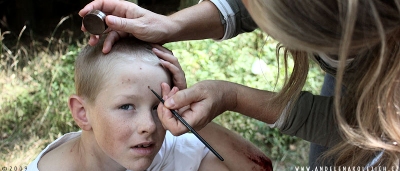
|
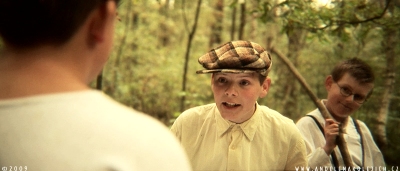
|
|
Now we had a team we tried to shoot a short technical picture to see how to
handle the results. It was good but we had no way to synchronize multichannel
sound with video. It was done manually - and as we found later in postproduction
it is crazy to do it that way . We tested a Depth of Field (DOF) adapter which we made
for the movie. It was necessary to have good filmic feeling and depth of field
was crucial. DOF was done by Jan Vlnas. We decided to shoot on a Sony FX1 camera,
which had good resolution and it was possible to adjust the DOF adapter for it.
Sound was recorded on Sony MD disk and premixed sound was recorded to camera. We
had decided that the team should only concentrate on filming and everything else would be solved
by production. That meant that production could look after food, transport, equipment,
scouting, scheduling etc. It was good decision and helped the team to focus. Then it was crucial to find actors. People from the theatre world helped us again. There was a children's theatre group too and we asked them to attend auditions. We had more than six rounds of auditions attended by over 100 so we had a good selection of actors. The angels were on our side again.
| |
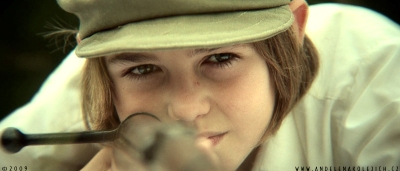
|
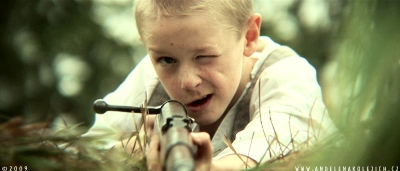
|
|
Finding locations and props was a challenge too. As it is an historical movie
and we had no money or experience to do a lot of postproduction we had to find
locations and props that were as realistic as possible. We sat in a car and drove around our nice country
and region and made notes of the best places. We took lots of photographs and identified
many wonderful locations. Our friend Robert Simek helped us immensely and lent us
his parents cottage. Staff at the
Museum of Komensky in Prerov let us shoot in their
historic classroom which was part of an exhibition. Many of the props were made
by us (newspapers, folders, water mills, sculpture of angels and so on). It was a tough
job but we were successful as the movie gives you a realistic impression of that era.
| |
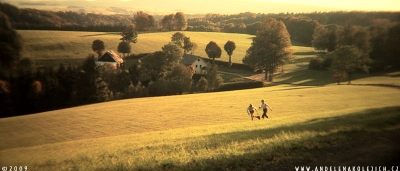
|
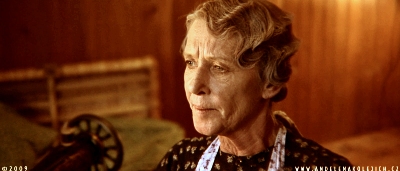
|
|
After all of this I was able to make the first shooting plan. We decided to shoot at
weekends because we had no vacation available and it wasn't possible to coordinate the
team on other days. But doing it that way made it hard to organize the transport of
people and equipment to the locations. We began with the childhood scenes and scenes in the cottage.
We shot there for three days. That is when I realised that my timings in the shooting plan
would have to be doubled and that we would need more shooting days than I initially thought.
There were various reasons for this: I didn't have accurate estimates. This was partly because
we shot with children - now I know why professionals say that shooting with children
and animals is tough ;). They were nice but they were still children. And it was
partly because Ondrej was so precise. He knew exactly what he wanted to shoot. This
is great for the movie but not for the production schedule ;). But we always found a solution.
| |
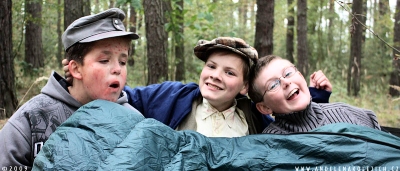
|
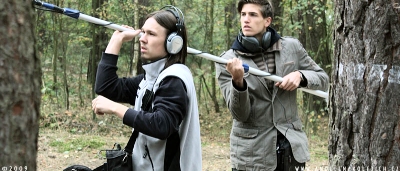
|
|
As we were only shooting at weekends we soon found that autumn was arriving. The last
scene with the children was shot at a temperature of about 5 degrees Celsius and the
boys were dressed in summer suits. But they were fantastic and behaved like professionals.
Their parents were enthusiastic and helped the boys during shooting. But there was no way to shoot
in autumn and winter because the script required summer weather. So we decided to wait
until the next summer. It was a good decision because we prepared the Angels on the Rail website , made the first edits and teasers and were able to prepare the next year's shooting schedule. Next we did more auditions and found very good actors for the adult parts. And I was able to find military and historic cars and guns and other requirements. And all that was possible because the website and teasers showed our capabilities. We decided to shoot in blocks instead of at weekends. We planned two blocks. The first nine-day block was at the start of the summer holidays when we shot the adult scenes in the cottage. The second three-day block was at the end of the holidays and was dedicated to the train scenes. Shooting in blocks was a good decision. All the team were focused on their work. Productivity was very high and we made great progress because all questions, problems and shooting plans and scenes were discussed quickly within the technical team who were all together - and production solved all the other issues. We took care of food, drinks, the schedule, calling and organizing and so on. We spent half our budget on food and drinks for the team ;). It is funny, because the rest was spent on petrol ;).
| |
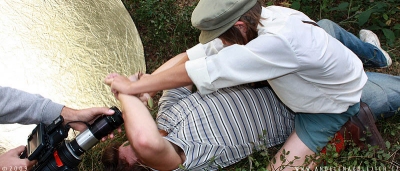
|
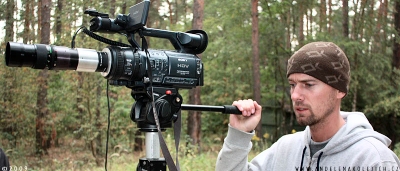
|
|
For the train scenes in the second block it was crucial to find free railway track and an
historic locomotive and coaches. We were able to attract train enthusiasts from the
Railroad Association because they loved our work and
we loved their enthusiasm. They agreed to let us use a locomotive with coaches, staff
and a stretch of track for a three day shoot. They had only one condition. I had to give
them coal for the locomotive. We found a company
Havelka
near our city and they agreed to sponsor us by giving us coal. Ok, we could start planning. But to begin we had to dress the station, track and so on for the war era. The entire team helped with this and we were able to change the old station into a 1940s station including the equipment, signs and notices etc. We have great memories of that time. Changing an old unfashionable building into an attractive historical one was a wonderful job. Shooting the train scenes was the biggest challenge of whole film. We had only three days for the most important scenes in the movie. Also, more than 40 people (team plus actors) were involved. And it was very difficult because of the sound. We shot during a real train ride and therefore it was a big challenge to master the dialogue. And all the team were under time pressure. During shooting we had found that it is crucial to have good assistant director. But our AD was the main actor in these scenes and he couldn't do both. But he tried as much as he could to help us. And Ondrej was able to handle it perfectly. My respect to him! Then we had two weeks of final shooting. One in a Museum of Railroad Signaling where we shot a scene in the railroad office and the other shooting exterior scenes on the way into the station. And the final shot was of the angel sculptures on the rail, the opening scene of the movie. We built and used a dolly track for that. It is funny that the angels scene was the last to be shot. We shot it in October 2009, 14 months after the first edit and 2 years after the deal with Ondrej. But the movie was not finished yet. The whole of postproduction had still to be done. Postpoduction was mainly controlled by Ondrej. He worked very hard and made several versions together with Martin Sestak (the main actor) who helped with editing. And Vojtech as sound supervisor worked very hard too, because he had to do all the sound synchronization. The company DISK supported us and they lent us equipment for sound postproduction free of charge. Ondrej found a very good nonprofessional composer Tomas Bocan who was able to compose music that was perfect for our movie. Ondrej spent a couple of days with him in deep discussions about music and the emotional composition of the movie. We did postsynchronisation on some scenes using native German speakers. We were lucky as the director of cinema Central in our city allowed as to tune the sound in the real cinema hall with a 4k Sony Alta projector and Dolby Surround sound. We were able to do the tuning only at night from 10pm to 6am when there were no commercial screenings. Vojtech and Ondrej worked very hard and became extremely tired. All that precise postproduction done by Ondrej took 8 months to complete. On May 7th 2010 we presented our movie to the public at a premiere. The last bit of work on the movie was done on the morning of 7th May ;). We spent more than two weeks preparing for the premiere. We printed posters (placards) that Michaela Capova had prepared and sent invitations to all participants. And on that evening more than 300 people were sitting in the cinema watching our movie. We were very nervous and worried about the audience opinion. But the people surprised us as they were crying and smiling throughout the entire 55 minutes. At the end there was a standing ovation. More than 10 minutes of standing ovation. It wasn't our personal ovation. It was for everyone who cooperated with us, for everyone who helped and for the more than 170 people who participated in it. And it was for the angels who were on our side for more than two and a half years of production. I will never forget that feeling. And I say to everyone who wants to do the same: "Yes guys, it makes sense. Do it, and angels will help you!!! Just keep to your aim and believe in yourself, your friends and other people who want to help you. Believe me, I have experienced it!".
PS:
Finally I would like to summarise what we learnt: Enjoy your filming!!! Vaclav Maixner July 2012
Share your passions.
Share your stories.
| |